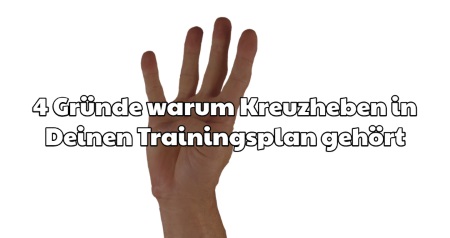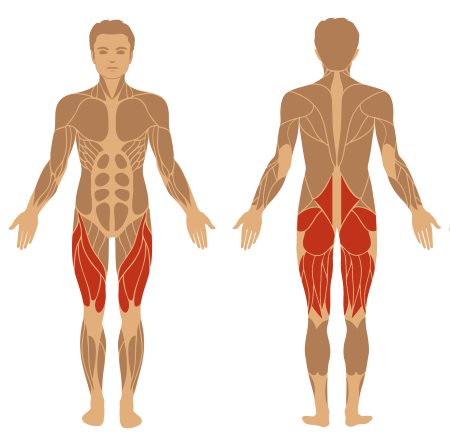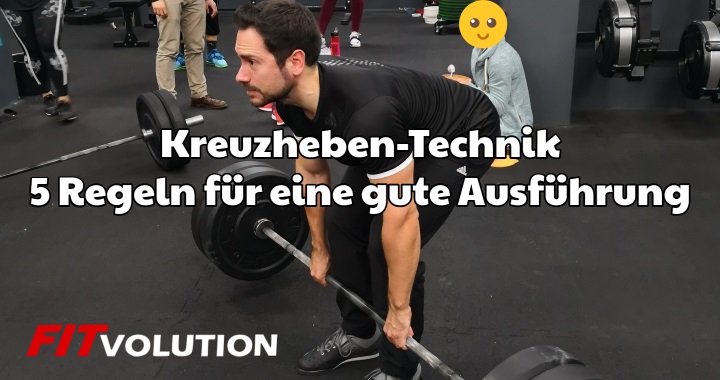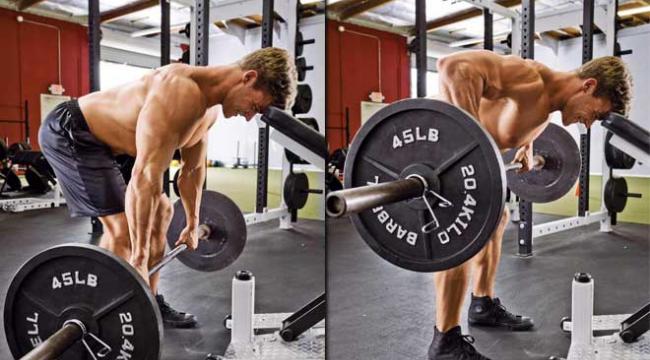Deadlift Technique – 5 Rules for Good Execution
Deadlift is probably the most controversial exercise among the hard core exercises. It is said to be bad for the back and there are several scary stories of injuries and ailments from the cravings in circulation. With the right deadlift technique, you are actually doing the opposite. You strengthen and stabilize the lower back and thus protect the spine in all situations. For this reason, its variants are often used in the field of rehabilitation.
I have long been skeptical about cravings. However, it is also because I keep seeing people whose pulls are not very good. This is mainly because they never got it. However, in the end, I was sometimes even more papal than fitness dad when it came to executing other people. Today I know that you never have to do everything 100% perfect for this exercise to be beneficial and not harmful.
However, in my opinion, there are a few things that are really very important. Here are some rules to watch out for if you want to improve your deadlift technique. If you take these things to heart, your performance will be significantly better than most other exercises. Plus, you don’t get lost in detail unnecessarily. In this article, I want to introduce you to what I think.
I have divided the article into the following sections. With one click, you will be taken directly to the section that interests you the most.
After reading, you should know enough about deadlift to use it with good deadlift technique for training.
Why you should deadlift

There are many good reasons to make the deadlift your main exercise in your workout plan. This applies no matter what your current learning goal is. If you want to build muscle and do hypertrophy workouts, deadlift is part of your plan, as well as endurance training. I will explain to you why this is so and which arguments are most important in my opinion.
1) Deadlifts – An Effective Comprehensive Basic Exercise
In my opinion, basic exercises should always form the basis of your training plan. These exercises can be performed with free weights or with your own body weight. They are characterized by the fact that large parts of the body are exercised at the same time and thus provide a good foundation for effective training.
Among the main exercises, the deadlift is especially functional, and in addition to squats, most and largest muscle groups are activated here. Unlike isolation exercises, the entire cardiovascular system is also heavily stressed. This is why these exercises are especially difficult for my morning exercises.
This results, among other things, in improved blood circulation and a more efficient supply of nutrients. This also means that the energy consumption is very high. This is very useful if you want to define muscles. Large amounts of growth hormones are also released. It will help you develop your muscles.
2) You get strong core muscles
Core muscles are often referred to as the body’s center of strength. These muscle structures are involved in virtually every movement in sports as well as in everyday life. No other complex exercise requires or trains your core muscles, and especially your lower back, as effectively as deadlifts and their variants. Even in the squat, where the central muscles also play a central role, the activation of the main muscles is nowhere near as high.
By the way, many back problems can be improved, eliminated or prevented by strengthening the muscles of the trunk and back. This is where cravings with good execution can play a crucial role.
3) Preventing injury with good deadlift technique
This argument follows from the previous two, but I would like to emphasize it again. In all day to day situations where you need to lift something, good deadlift technique is helpful and helps prevent injury. You just instinctively know how to pick up heavy things.
Plus, with regular exercise, your core body becomes strong and stable in all other situations. You can also better deal with other day-to-day problems. If one or the other has back problems directly because they had to wear something, you are already thinking about your next workout.
4) Increasing the effectiveness of training with deadlift
By the way, more strength and stability in your core will also benefit you in your other exercises. So if you are using good form deadlifts to improve core stability, then in the medium term it will also affect your performance in many other exercises in the medium term. This way, you can usually increase your strength a little faster. This, in turn, also has a positive effect on your muscle training.
What muscles are trained in the deadlift
As mentioned earlier, the deadlift is a difficult basic exercise. Different muscle groups are needed accordingly. The following muscle groups train especially hard:

Simply put, when you do the deadlift, you train your lower back, front and back thighs, and pomus muscles. Those who would like to know something more precise are in fact the following muscles:
- Back Extension Erector Muscle
- Quadriceps femoris – quadriceps femoris
- Gluteus maximus – gluteus maximus
- Leg Biceps – Hip Biceps
- Half-sinus muscle – semidendinous muscle
- Semi-membranous muscle with platinum vision
These are mainly the main traction muscles. In addition, the broadest muscles of the arms and abdomen are involved to a large extent. If you do not have the means to pull. Your forearms will probably even quickly become your weakest link because the deadlift requires a lot of strength.
Because of these circumstances, it is often debated whether the deadlift in split training is more likely due to leg or back exercises. My opinion is very clear: Exercise with so many legs is part of leg day. In addition, I also hide the lower back from the upper body tag (for 2-way splitting) or tear-off tag (for 3-way splitting). Which split learning plan is right for you depends on you, your time, your experience and your preferences.
What You Should Consider For Good Deadlift Technique

Now we finally get to the thrust. There are many subtleties to look out for in the deadlift. However, I have noticed where mistakes are often made and how you can quickly improve your deadlift with just a few things to watch out for.
Next, I would like to briefly introduce you to the 5 most important rules of good deadlift technique.
Deadlift Technique Rule 1. Straight Back
Most of the strength comes from the lower back, as the name suggests, in the deadlift. For this reason, it is imperative that everything works correctly here. So make sure you keep your back straight to avoid making a rounded back or a strong hollow back. Minimal rounding or slight lordosis is ok.
First of all, you should pay close attention to the straight back and throughout the movement. If there are problems with the deadlift, it is in most cases due to overload combined with an unhealthy spine position. If you keep your back straight, you are doing a lot of things right.
Also keep in mind that your back can be rounded up and down. So there are two points that you should focus on. By the way, the following rules also make it easier for you to keep your back straight.
Deadlift Rule 2: Body Tension
Stable position and maximum body tension during the entire movement are essential for flawless execution of the deadlift. This includes primarily tension in the upper and lower back. If you have tension problems in your upper back and your chest collapses, try to imagine how you want to pinch and hold a tennis ball between your shoulder blades.
In addition, your legs and your structure must be tense throughout the entire movement. Be sure to create this tension before starting the movement. If you find it difficult, shortly before starting the movement, imagine that you have already started the movement. It may sound strange, but this simple mental training has helped some.
You maintain the tension of your body and thus develop your strength by paying attention to correct breathing. Take a deep breath before moving, inhale the air inward and contract your abdominal muscles.
You should always pause between sets so that you can truly maintain tension throughout the exercise.
Deadlift Rule 3: Barbell Near Leg
In the starting position and on the way to the classic deadlift, you stand close and straight, with your shoulders above the barbell, which is very close to your lower leg. The ideal position is theoretically about halfway between the toes and shins. However, I have found that this trend usually goes too far ahead.
If you make sure the bar is as close to your shins as possible, you will learn better. It also helps you follow Rules 4 and 5. If you don’t and you have a barbell next to your shin, your knees are in the way.
Are there any bruises at the beginning? Probably! But if you’re putting on heavy sweaty deadlift joggers like me, that’s not too bad.
I often see exercisers leaning forward during the deadlift due to a sub-optimal shift in their center of gravity. It can also be difficult to keep your back straight. When combined, it looks pretty unhealthy.
If you make sure you start with a barbell close to your shins and shoulders above the plank, this won’t happen to you.
Thrust Version Rule 4: Push Your Ass Backward / Forward
In addition to erections, the hip extension is the center of the thrust. This is not very easy for me to digest.
For me, and for many of the people I have observed, it is especially important to consciously push your hips back on the way down. If you don’t, your back is too steep and you will take your lower back out of play, or your knees will end up getting in your way and it will be much more difficult for you to keep your back straight.
Likewise, on the way up, you must consciously push your hips forward while stretching and straightening your legs. This is the only way to get the tension and flow you need for pure traction.
Deadlift Rule 5: Smooth Movement
Last but not least, one thing that you already partially covered in the fourth rule. The point is, a good and healthy deadlift should always be a fluid motion.
I know this is easier said than done. However, if you are doing the straightening, extension of the legs and hips as parallel as possible, then you have already made a giant leap towards really good deadlift technique.
Once it all looks a little coherent and bumpy, don’t worry and keep working on it. The feeling comes to him over time, if you pay attention to it. This is easier said than done, especially in the extreme area of maximum strength training. As I get heavier, I sometimes start to stretch my legs and then straighten and push my hips forward. So I am also constantly working on my technology.
But never make sudden movements to create a certain weight! You can really avoid them because apart from the increased risk of injury, they really do nothing for you.
Bonus tip: have someone watch your execution over and over
Now this is not a rule of thumb, but very valuable for good deadlift technique. If you have the opportunity to train with a training partner, use that too. Ask them to pay attention to your execution. Have them shoot videos of your technique over and over again. Offer him or her the same. So you both benefit from it.
Sometimes you just see things differently than they look on the outside, and you don’t notice mistakes. They can also creep in very slowly. A learning partner will help you recognize them and respond quickly to them.
If you don’t have someone to accompany you during your workout, then at least regularly take selfies. It is best to do this from the outside so that you can recognize common error sources as quickly as possible.
If you just pay attention to these things and use them one by one to gradually improve your deadlift performance, you will be doing better deadlifts in a short amount of time than 99% of the people who work in gyms.
Here’s a video of me doing deadlifts
This is how it might look. Execution is not always 100% perfect for me, but as I said, it’s especially important that you focus on the things that really matter and will improve your technique quickly.
Which traction accessories make sense
At the latest, when you’ve been training a little longer and doing deadlifts as well, but probably much earlier, you’ll ask yourself about good equipment. After all, you want to get the most out of your workouts.
Below I would like to introduce you to the recommended traction equipment and briefly explain whether it makes sense and under what circumstances to use it.
Weightlifting shoes
Opinions differ on traction weightlifting shoes. This is because they have their own advantages and disadvantages.
Actually, deadlift weightlifting shoes are probably not ideal. The distribution of the load on the foot is not optimal due to the wedge under the heel. A raised heel also pushes your knees forward, increasing the risk of your knees getting in your way as you move up. In addition, the distance that the bar must travel has been increased. This may slightly reduce the possible weight.
On the other hand, so-called lifts have a tough, stable and non-slip outsole for a secure and stable stance, which in turn simplifies a clean design. This makes them more suitable than all traction sneakers. This is especially true if the wedge is not too high. Therefore my sports shoes have a rather flat wedge.
I personally wear my Adidas Powerlift weightlifting shoe for traction. This is because I wear them anyway for good squatting technique so I can be really steady. I don’t want to change my shoes to change the exercise. Barefoot training isn’t really an option for me in a public studio. In addition, I have absolutely no stable position on my toes and have already slipped away.
The really optimal thing would probably be to pull barefoot or change shoes, and for your traction – frank minimal shoes like Vibram Five Fingers to wear.

Traction means
Deadlift is probably an exercise where you see people who use pull-up aids the most. This is because the forearms are often the weakest link in the chain and are the first to fail when pulling. Traction aids can help here. The straps wrap around the core and significantly reduce the required grip.
However, you shouldn’t wear these chin-ups with every set to keep your forearms out of play. The goal should be to train without support for as long as possible, and then do a few reps for the last 2-3 heavy sets with pull-up aids that would have been impossible without. By the way, I would not recommend any traction aids as long as you are still learning the correct traction technique.
Personally, I am friends with aids as soon as higher weights are involved. I use these stretchers and I am very happy with them. These are simple but high quality standard tensioners made from fabric with light padding on the wrist, but no gumming. Everything else is, in my opinion, unnecessary bells and whistles.
Weightlifting belt
Perhaps in the future I will write my little article on the meaning and nonsense of a weightlifting belt. Here I just want to briefly express my opinion on the use of such traction belts. I am currently not using a deadlift. Most of the ambitious people I know swear by using a weightlifting belt for squats and deadlifts.
Such a belt, when used correctly, has the benefits of additional mid-body stabilization. However, this is not only due to wear, but also because the tension in the core can be increased by back pressure. This is because you have a lot to put pressure on.
I have a in my closet. Genuine leather heavy weight powerlifting belt. I do not currently use this in hypertrophy training. I just don’t need it, and it doesn’t bring me any significant performance benefits. I also believe that you are used to putting pressure on your belt. However, you should also achieve stability without support. When I train again in the IK training area, that is, with very high weights and low reps, then I will wear my training belt again, but only for heavy sets of work.
knee bandages
From time to time I have seen people doing deadlifts in the gym with knee bands. I do not use knee supports myself. I’ve tried this a few times and I just find them annoying and don’t think they do any good with classic deadlifts. They interfere with pulling the bar over the knee, make it difficult to bend the knee, and thus adversely affect the starting position.
For this reason, I will not make any recommendations here. If the knee bandage protector reads while pulling, then he can contact me or write a comment, so be sure to remove the bandages.
What are the alternatives to thrust
I am always asked about alternatives to great exercise. This happens especially often in the deadlift because some people want to avoid this exercise. As mentioned earlier, if you follow the rules of good deadlift and use good deadlift technique, worry is unnecessary.
I still want to mention some variations or alternatives to the classic deadlift, also known as the deadlift. After all, it’s perfectly legal to add variety to your training from time to time. In addition, different focal points can be set with different options. The most important alternatives or traction options in my opinion:
- Suml deadlifts: an alternative with a wider base, shorter path and less back strain
- Romanian Deadlift: Option without landing, for more hind muscle isolation
- Grab Rows: An alternative with a rear-shifted center of gravity, shorter stroke and shin protection
- Dumbbell Deadlift: Single or Double Dumbbell Option
Your conclusion on cravings
After reading this article, I hope you now know about the many benefits of regular deadlift exercise. You also need to know what to really look out for in order for your deadlift technique to be so good that you can progress safely and well. The accessories mentioned here are optional and can help you get a little more out of one or the other.
If you want to go even further, I also recommend that you do a technical checkup with a specialized instructor from time to time or attend a barbell workshop with one of the experts in the field. I’ve already attended several of these seminars and still take a lot with me.
